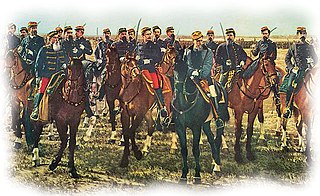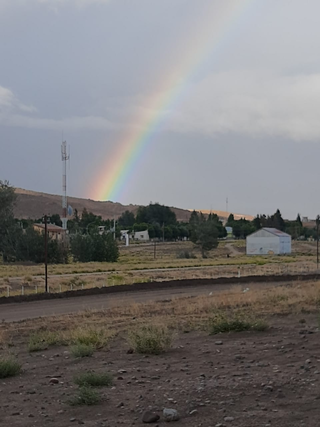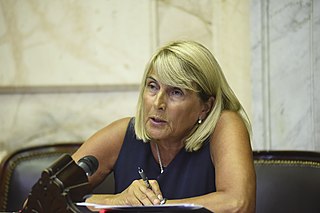
Río Negro is a province of Argentina, located in northern Patagonia. Neighboring provinces are from the south clockwise Chubut, Neuquén, Mendoza, La Pampa and Buenos Aires. To the east lies the Atlantic Ocean.

Neuquén is a province of Argentina, located in the west of the country, at the northern end of Patagonia. It borders Mendoza Province to the north, Rio Negro Province to the southeast, and Chile to the west. It also meets La Pampa Province at its northeast corner.
Neuquén is the capital city of the Argentine province of Neuquén and of the Confluencia Department, located in the east of the province. It occupies a strip of land west of the confluence of the Limay and Neuquén rivers which form the Río Negro, making it part of the ecoregion of Alto Valle del Río Negro. The city and surrounding area have a population of more than 340,000, making it the largest city in Patagonia. Along with the cities of Plottier and Cipolletti, it is part of the Neuquén – Plottier – Cipolletti conurbation.

The Conquest of the Desert was an Argentine military campaign directed mainly by General Julio Argentino Roca during the 1870s and 1880s with the intention of establishing dominance over Patagonia, inhabited primarily by indigenous peoples. The Conquest of the Desert extended Argentine territories into Patagonia and ended Chilean expansion in the region.

LRA Radio Nacional, also known as Radio Nacional Argentina, is the Argentine national radio station, and part of the national public media system. It started transmitting in 1937 as LRA Radio del Estado and changed its name to the current one in 1957. Since 1949, National Radio is also in charge of the Radiodifusión Argentina al Exterior, an international service that broadcasts in numerous languages.

Notosuchus is an extinct genus of South American notosuchian crocodylomorph. It was terrestrial, living approximately 85 million years ago in the Santonian stage of the Late Cretaceous.
Las Lajas is a town in Neuquén Province, Argentina, and the capital of Picunches Department. The town, at an altitude of 900 metres (3,000 ft) above mean sea level, is located on the right shore of Agrio River at the Andean foothills. National Routes 22 and 40 intersect in this area of the central Neuquén Province. The Cuchillo Curá range, considered the most important underground ecosystem in Argentina, extends approximately 10 kilometres (6.2 mi) from Las Lajas.

The National University of Comahue is an Argentine national university with branches in the provinces of Neuquén, Río Negro and Chubut, with a centre in the city of Neuquén and units in Viedma, Bariloche, San Martín de los Andes, Cipolletti, Zapala, Allen, General Roca, Choele Choel, San Antonio Este, Villa Regina, Esquel, Puerto Madryn and Trelew. It is the largest public university in Argentine Patagonia.

Neuquén Basin is a sedimentary basin covering most of Neuquén Province in Argentina. The basin originated in the Jurassic and developed through alternating continental and marine conditions well into the Tertiary. The basin bounds to the west with the Andean Volcanic Belt, to the southeast with the North Patagonian Massif and to the northeast with the San Rafael Block and to the east with the Sierra Pintada System. The basin covers an area of approximately 120,000 square kilometres (46,000 sq mi). One age of the SALMA classification, the Colloncuran, is defined in the basin, based on the Collón Curá Formation, named after the Collón Curá River, a tributary of the Limay River.
El Manso is a village and municipality in Río Negro Province in Valle El Manso in Argentina. Located in the vicinity of Chile El Manso was settled in the late 19th century by Chileans of mestizo and Mapuche stock as well by European immigrants. Chiloé Archipelago in particular was the place of origin of most Chilean settlers. Early settlers engaged in subsistence farming.

The General San Martín Monument, located in the city center of Neuquén, Argentina, is a memorial built to commemorate Argentinian general José de San Martín. The monument is constituted by a bronx-made equestrian statue of San Martín, mounted on a pedestal.
The Neuquén-Cipolletti bridges are a series of four bridges that connect the cities of Neuquén and Cipolletti by spanning the Neuquén River, in Argentina. Three parallel ones, two road bridges and a railway bridge, were built on a former herd wrangling path. The fourth one was built upstream.

Tren del Valle is a 10 km (6.2 mi) commuter rail service that connects cities of Plottier, Neuquén and Cipolletti, in the Río Negro and Neuquén Provinces of Argentina, running on Roca Railway tracks. In a future stage, the line could be extended west to Senillosa and east to General Roca.

The Huincul Fault or Huincul Fault Zone is an east-to-west-oriented, continental-scale fault that extends from the Neuquén Basin eastwards into the Argentine Shelf. To the west, it has been proposed to extend across the Andes to the Chilean Coast Range.

The Collón Curá Formation is a Middle Miocene fossiliferous geological formation of the southern Neuquén Basin in northwestern Patagonia and the western Cañadón Asfalto Basin of central Patagonia, Argentina. The formation crops out from the southern Neuquén Province, the western Río Negro Province to the northern Chubut Province.

Neuquén is a train station in the homonymous city in Argentina, which is served by the Ferrosur Roca's Zapala-Bahía Blanca freight service and the Tren del Valle commuter service. Situated on the Central Park in the city center, adjoining other historical railway constructions such as the Emilio Saraco Art Gallery, it was declared a building of historical relevance by the National Government. Opened in 1902, the station played a significant role in the region's development and the decision to declare it the capital of the National Territory, which was to become the current Province in 1955.

Alma Liniana "Chani" Sapag is an Argentine politician who served as a member of the Argentine Chamber of Deputies elected in Neuquén Province from 2017 to 2021. A member of the Neuquén People's Movement (MPN), Sapag has previously served as a councilwoman in Caviahue and as a member of the Neuquén provincial legislature.

Rolando Ceferino Figueroa is an Argentine politician, currently serving as a National Deputy elected in Neuquén Province. A member of the regionalist Neuquén People's Movement party until 2022, Figueroa was elected in 2021 and currently sits in the Provincias Unidas inter-bloc.
Propachyrucos is an extinct genus of hegetotheriid notoungulate. It lived from the Late Oligocene to the Early Miocene, in what is today South America.
The Chichinales Formation is a geological formation in Río Negro Province, Argentina which dates from the Late Oligocene to the Early Miocene, around 23 to 17.5 million years ago. It predominantly consists of pyroclastic deposits, which were deposited in a semi-arid environment. It is divided up into a number of members. The diverse fauna of the Chichinales Formation, including a variety of turtles and birds, also includes many mammals such as South American native ungulates as well as armadillos, and caviomorph rodents.





















